
In botany, a rosette is a circular arrangement of leaves or of structures resembling leaves.
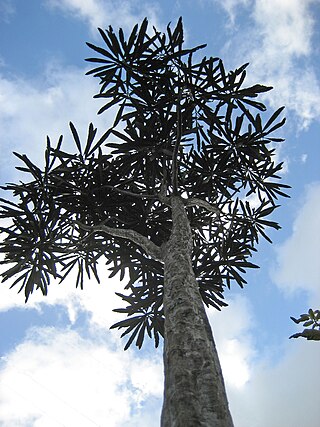
Pseudopanax crassifolius, also known as horoeka or lancewood, is a heteroblastic tree belonging to the family Araliaceae. It is endemic to New Zealand and found throughout the country from sea level up to about 750 m in lowland to montane shrublands and forests.

Clianthus puniceus, common name kaka beak, is a species of flowering plant in the genus Clianthus of the legume family Fabaceae, native to New Zealand's North Island.

Pennantia baylisiana, commonly known as Three Kings kaikōmako or kaikōmako manawatāwhi (Māori), is a species of plant in the family Pennantiaceae. It is endemic to Manawatāwhi / Three Kings Islands, around 55 kilometres (34 mi) northwest of Cape Reinga, New Zealand. At the time of its discovery just one plant remained. This single tree grows on a scree slope inaccessible to browsing goats, and has been called "the world's loneliest tree". The species was discovered in 1945 by botanist Geoff Baylis and described in 1948, although it took decades before it was it was fully accepted as a distinct species of Pennantia. Although the only wild tree is female, it was successfully propagated from cuttings in the 1950s, one of which was induced to self-pollinate in 1985. Subsequent seed-grown plants have themselves set seeds, and the species has been replanted on the island, the adjoining mainland, and in public and private gardens around New Zealand.
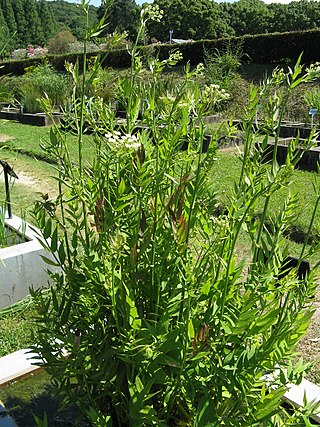
Sium suave, the water parsnip or hemlock waterparsnip, is a perennial wildflower in the family Apiaceae. It is native to many areas of both Asia and North America. The common name water parsnip is due to its similarity to parsnip and its wetland habitat. The alternate common name hemlock waterparsnip is due to its similarity to the highly poisonous spotted water hemlock.

Myrsine australis, commonly known as māpou, red matipo, tīpau, and mataira is a species of shrub within the family Myrsinaceae. It is endemic to New Zealand, found throughout both the mainland and offshore islands.
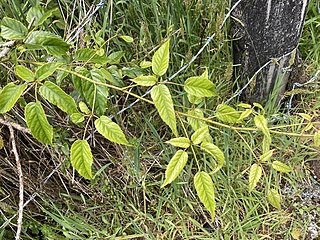
Rubus cissoides, commonly called bush lawyer or tātarāmoa in te reo Māori, is a species of flowering plant in the family Rosaceae, endemic to New Zealand. Alan Cunningham described R. cissoides in 1839. Plants of this species of are perennial scrambling vines with compound leaves with 3-5 leaflets each up to 15 cm long, reddish prickles on the branches, white flowers from September to November and red berries from December to April. The conservation status of R. cissoides is Not Threatened, it is widespread on all three main islands of mainland New Zealand, and it has been used by Māori as food, medicines and construction materials.

Azorella polaris, commonly known as the Macquarie Island cabbage, is a species of flowering plant usually placed in the family Araliaceae or Apiaceae and only very distantly related to cabbage. It is a megaherb, growing up to about a metre in height, native to the subantarctic islands of New Zealand and to Australia’s Macquarie Island.

Melicytus lanceolatus, commonly called narrow-leaved māhoe or māhoe-wao, is a small tree in the family Violaceae that is endemic to New Zealand.

Griselinia lucida, commonly known as puka, akapuka or shining broadleaf, is an epiphytic plant native to New Zealand. G. lucida naturally occurs in wet lowland-forests and open or rocky coastal environments mostly in the North Island of New Zealand, and restricted areas of the South Island.

Aciphylla aurea, known as taramea in Māori and golden speargrass or golden Spaniard in New Zealand English, is a large, spiky, tufted plant with sharp yellowish-green leaves in the speargrass genus Aciphylla. A. aurea is found throughout the South Island of New Zealand in montane to low alpine habitats.

Mabrya is a genus of flowering plants in the plantain family, Plantaginaceae. It consists of herbaceous perennials with brittle upright or drooping stems, found in dry areas of Mexico and the southern United States.

Pterostylis auriculata is a species of orchid endemic to New Zealand. Unlike many other greenhood orchids, this species lacks a rosette of leaves but instead only has leaves on the flowering stem. All parts of the plant are glossy and there is a single green flower with a reddish tinge.
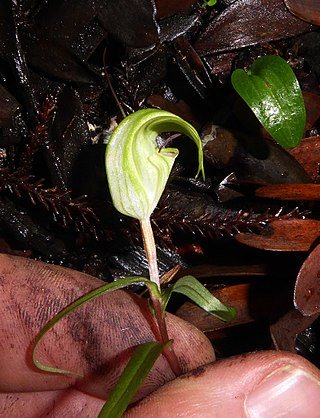
Pterostylis brumalis, commonly known as the kauri greenhood or winter greenhood, is a species of orchid endemic to New Zealand. There is a rosette of leaves at the base of both flowering and non-flowering plants. Flowering plants have a white flower with narrow green stripes and a dorsal sepal which bends forward strongly while the petals spread widely, giving the flower a cobra-like appearance.

Microtis oligantha, commonly known as the small onion orchid is a species of orchid endemic to New Zealand. It has a single thin, hollow, onion-like leaf and up to ten small green flowers. It differs from the other two onion orchids in New Zealand, in being a much smaller plant with a more pointed dorsal sepal.
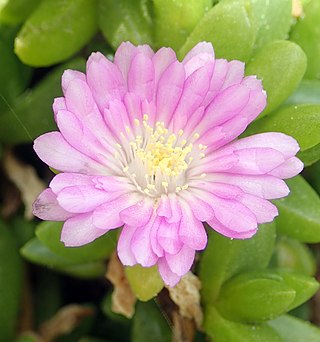
Disphyma papillatum, commonly known as Chatham Island ice plant, is a species of flowering plant in the family Aizoaceae and is endemic to the Chatham Islands of New Zealand. It is a succulent, prostrate herb with flattened, pimply, trailing stems, leaves that are triangular in cross-section, and white to pink, dark blue or purple daisy-like flowers.
Kandaharia is a monotypic genus of flowering plants belonging to the family Apiaceae. It only contains one known species, Kandaharia rechingerorum. It is in subfamily Apioideae and also tribe Tordylieae subtribe Tordyliinae.

Corybas iridescens is a species of terrestrial orchid endemic to the New Zealand. It has a solitary fleshy oval-shaped leaf and a single deep crimson flower, sometimes accompanied with green, with a tapering dorsal sepal.

Zosima is a genus of flowering plants belonging to the family Apiaceae.

Kunzea sinclairii, also known as the Great Barrier Island kānuka, is a flowering plant in the myrtle family, Myrtaceae and is endemic to Great Barrier Island in the Auckland Region, New Zealand.



















